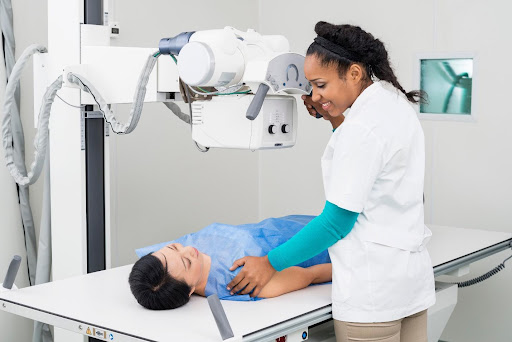The healthcare field is vast and diverse. There is a large cast of characters (so to speak) that are involved in helping us get the care we need when we are sick or injured. Radiologic Technologists are among those healthcare professionals that we may rely on and interact with during our visit. You may be wondering though, “What is a Radiologic Technologist?”
Perhaps you have an idea of what a Radiologic Technologist is, but have wondered, “What does a Radiologic Technologist do?” Well, you’re in luck! Today we’re breaking down some basics on Radiologic Technologists, including who they are, where they work, and what they do. Continue reading below to learn more about Radiologic Technologists and the role they play in healthcare.
What is a Radiologic Technologist?
First things first, let’s tackle the question, “What is a Radiologic Technologist?” When patients visit their doctor, a clinic, or hospital for care and are sent to receive x-rays, they will likely be in the care of a Radiologic Technologist.
A Radiologic Technologist is a healthcare professional that is trained to administer ionizing radiation for medical diagnostic imaging purposes. Wait, what? Okay, let’s break this down a little further. The Radiologic Technologist is often the person that meets with a patient before their x-rays. They are responsible for not only setting up the room and the equipment but explaining to the patient the process they will undergo when they are sent for x-rays.
Radiologic Technologists also administer the equipment, properly position (or re-position) patients, and ensure patient safety throughout the process to obtain imaging scans. These scans can be critical in your doctor (or healthcare provider) being able to come up with a diagnosis, so it’s important that they are as accurate and precise as possible. That’s a big part of the Radiologic Technologist’s job – to get the best images/scans possible.
To ensure the scans are good, the Radiologic Technologist reviews imaging scans to ensure quality. They will also follow-up with physicians, maintain patient records, monitor patients, and adhere to standards and regulations to promote safety.
Radiologic Technologists can work in any healthcare practice that administers x-rays or image scanning. They are typically found working in hospitals, clinics, and physicians’ offices. The work Radiologic Technologists do is critically important, because as we noted above, providers rely on the x-rays to help provide a picture (pardon our pun!) of what might be happening with a patient.
What does a Radiologic Technologist do?
At a high level, we talked about the responsibilities a Radiologic Technologist may have, but when it comes to specific job duties, you may still be wondering, “What does a Radiologic Technologist do?” While job duties may vary from one healthcare facility to another, there are some typical job duties that Radiologic Technologists usually perform.
Typical duties of a Radiologic Technologist may include the following:
- Positioning the patient on the exam table, set up the equipment, and make the necessary adjustments to obtain the best possible scan of the area as requested in the order.
- Operate equipment to produce images of specific areas of the body for diagnostic purposes.
- Use appropriate safety measures and protection devices to comply with regulations and to ensure the safety of patients and staff.
- Explain procedures to patients.
- Observe patients during procedures.
- Obtain information from patients and update medical records and charts accordingly.
- Monitor patients during and after scans. Report abnormalities to the physician.
- Adhere to quality control measures and standards.
- Set up exam rooms and equipment.
- Review and evaluate completed x-rays to ensure they are sufficient for evaluation by the physician.
As you can see, the duties of a Radiologic Technologist can be varied but usually follow a process flow from start to finish. This can be a great career for someone who is a “thinker,” a problem solver, has good attention to detail, and communication skills.
The Associate of Applied Science in Radiologic Technology program at Dorsey College
The hybrid Associate of Applied Science in Radiologic Technology program is designed to prepare individuals to pursue a career as a Radiologic Technologist, also known as a Radiographer or an X-Ray Technician. The curriculum in Dorsey College’s program is comprised of specialized courses in radiography with concentrated study in the basic sciences and mathematics. Emphasis is on radiation protection and quality patient care. Upon successful completion of the program, provided all requirements for graduation are met, the graduate will receive an Associate of Applied Science in Radiologic Technology, and may be eligible to sit for the American Registry of Radiologic Technologists (ARRT) registry examination to become a registered radiographer.
The Associate of Applied Science in Radiologic Technology program is offered at the Dorsey College Dearborn campus (a branch campus of Madison Heights).
To learn more about how you can train to become a Radiologic Technologist, contact Dorsey College today to get more info on the Associate of Applied Science in Radiologic Technology program!

